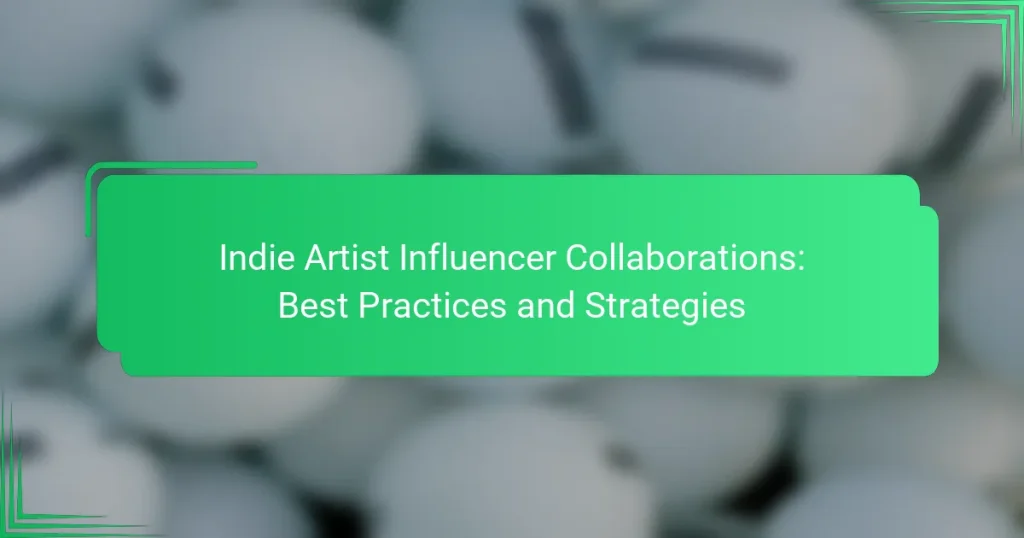Collaborating with influencers can be a game-changer for indie artists, offering opportunities to expand their reach and enhance their creative output. By strategically partnering with influencers whose audiences align with their own, artists can create compelling content that resonates with fans and fosters engagement. Clear communication and shared goals are essential for successful negotiations, ensuring that both parties benefit from the collaboration.

What Are Effective Collaboration Strategies for Indie Artists?
Effective collaboration strategies for indie artists involve leveraging partnerships to expand reach and enhance creativity. By working together, artists can tap into each other’s audiences and create unique content that resonates with fans.
Leveraging Social Media Platforms
Indie artists should utilize popular social media platforms like Instagram, TikTok, and Twitter to connect with collaborators and their audiences. Regularly posting updates, behind-the-scenes content, and interactive stories can help maintain engagement.
Consider hosting joint live sessions or Q&A events to foster community interaction. This not only promotes the collaboration but also encourages followers to share the content, increasing visibility.
Creating Engaging Content Together
Collaborative content should be fresh and engaging, whether it’s a music video, a podcast episode, or a series of blog posts. Artists can brainstorm ideas that highlight their unique styles while appealing to both fan bases.
Utilizing formats like challenges or themed series can drive interest. For example, a weekly song cover challenge can encourage fans to participate and share their versions, creating a buzz around the collaboration.
Utilizing Email Marketing Campaigns
Email marketing remains a powerful tool for indie artists to announce collaborations and share exclusive content. Building a joint mailing list can help both artists reach a wider audience with targeted messages.
Consider offering incentives, such as free downloads or exclusive behind-the-scenes content, to encourage sign-ups. Regular updates about the collaboration can keep fans engaged and excited.
Participating in Live Events
Live events, whether virtual or in-person, provide a dynamic platform for indie artists to showcase their collaborations. Participating in festivals, open mics, or online concerts can attract new listeners and create memorable experiences.
Artists should promote these events across their social media and mailing lists to maximize attendance. Engaging with the audience during these events can strengthen connections and encourage future collaborations.
Cross-Promoting on Streaming Services
Cross-promotion on streaming services like Spotify and Apple Music can significantly boost visibility for indie artists. By featuring each other’s tracks in playlists or creating collaborative playlists, artists can introduce their music to new listeners.
Additionally, consider releasing a joint single or EP to capitalize on both fan bases. Promote these releases through social media and email campaigns to drive traffic and streams on the platforms.
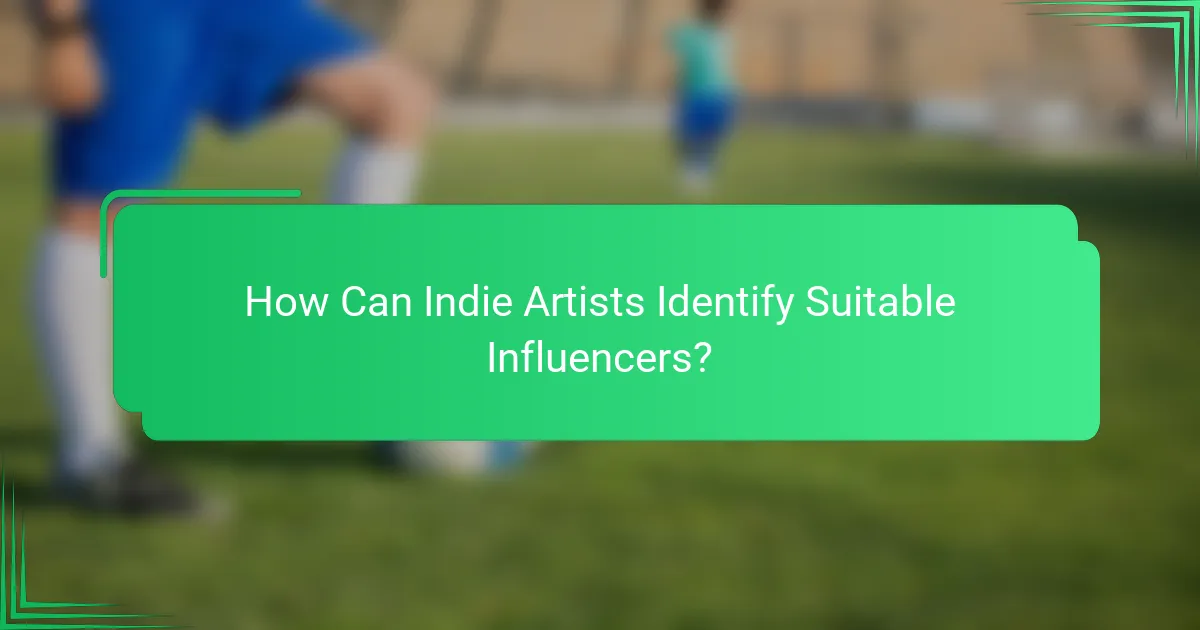
How Can Indie Artists Identify Suitable Influencers?
Indie artists can identify suitable influencers by focusing on those whose audience aligns with their target demographic and whose content resonates with their music style. This involves researching potential influencers to ensure a mutually beneficial partnership that can enhance visibility and engagement.
Researching Audience Demographics
Understanding the audience demographics of potential influencers is crucial for indie artists. Look for influencers whose followers match your target age group, location, and interests. Tools like social media analytics can provide insights into follower statistics, helping you gauge whether the influencer’s audience aligns with your own.
For example, if your music targets a younger audience, seek influencers who primarily engage with users aged 18-24. This alignment increases the likelihood of reaching potential fans effectively.
Analyzing Engagement Rates
Engagement rates are a key indicator of an influencer’s effectiveness. High engagement rates, typically ranging from 1% to 5%, suggest that the influencer’s audience is actively interacting with their content. Look for influencers who not only have a large following but also generate meaningful interactions such as likes, comments, and shares.
To analyze engagement, calculate the average number of interactions per post divided by the total followers. This metric helps you identify influencers who can drive real interest in your music rather than just superficial visibility.
Evaluating Content Alignment
Content alignment between your music and the influencer’s style is essential for a successful collaboration. Review the influencer’s previous posts to determine if their content themes, tone, and aesthetic resonate with your brand. This ensures that any promotional efforts feel authentic and relevant to their audience.
For instance, if your music has a laid-back vibe, collaborating with an influencer who shares similar lifestyle content can create a natural fit. Avoid influencers whose content diverges significantly from your artistic identity, as this may confuse or alienate potential fans.
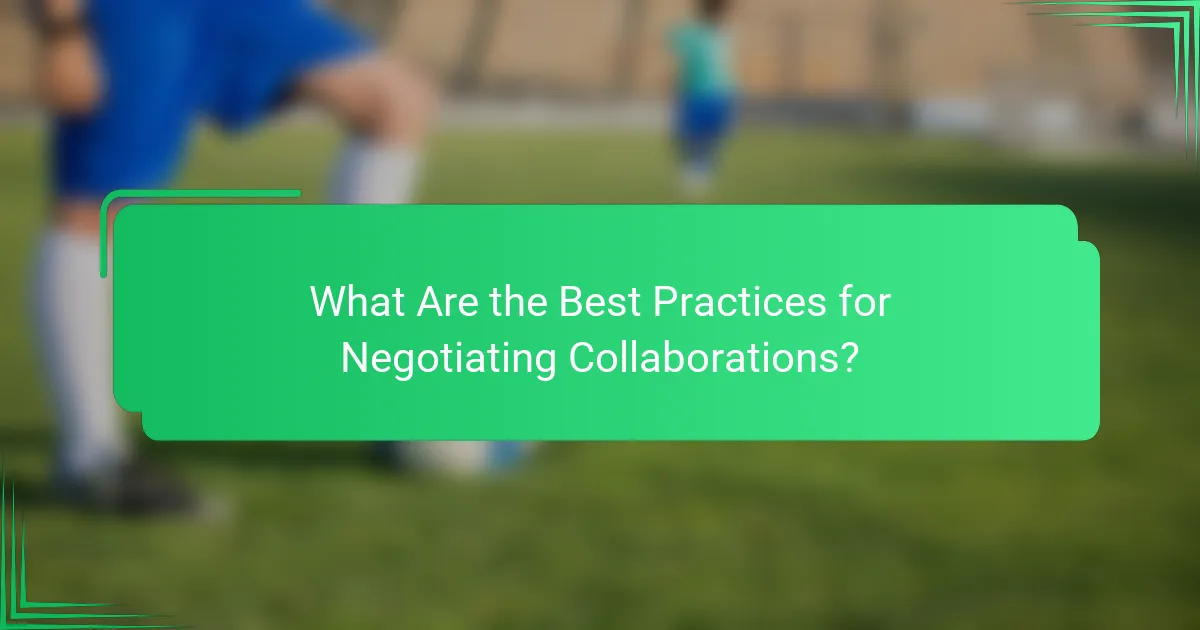
What Are the Best Practices for Negotiating Collaborations?
Effective negotiation for collaborations between indie artists and influencers involves clear communication, mutual understanding, and strategic planning. Establishing shared goals and expectations is crucial to ensure a successful partnership.
Establishing Clear Objectives
Setting clear objectives is the foundation of any collaboration. Both parties should define what they hope to achieve, whether it’s increased exposure, sales, or content creation. This alignment helps in crafting a focused strategy that benefits everyone involved.
Consider using SMART criteria—Specific, Measurable, Achievable, Relevant, Time-bound—to outline these objectives. For example, an indie artist might aim to increase their social media following by 30% within three months through influencer promotion.
Defining Roles and Responsibilities
Clearly outlining roles and responsibilities prevents misunderstandings and ensures accountability. Each party should know their specific tasks, such as content creation, promotion, or audience engagement.
A simple way to define these roles is to create a collaborative agreement that details who is responsible for what. For instance, the artist may handle the creative aspects, while the influencer focuses on distribution and audience interaction.
Setting Fair Compensation Models
Compensation models should reflect the value each party brings to the collaboration. This can include monetary payment, product exchanges, or a combination of both. It’s essential to agree on a model that feels equitable to both sides.
Common compensation structures include flat fees, commission-based payments, or performance bonuses based on metrics like engagement or sales. For example, an artist might offer a flat fee of $500 for a promotional post, or a 10% commission on sales generated through the influencer’s referral link.
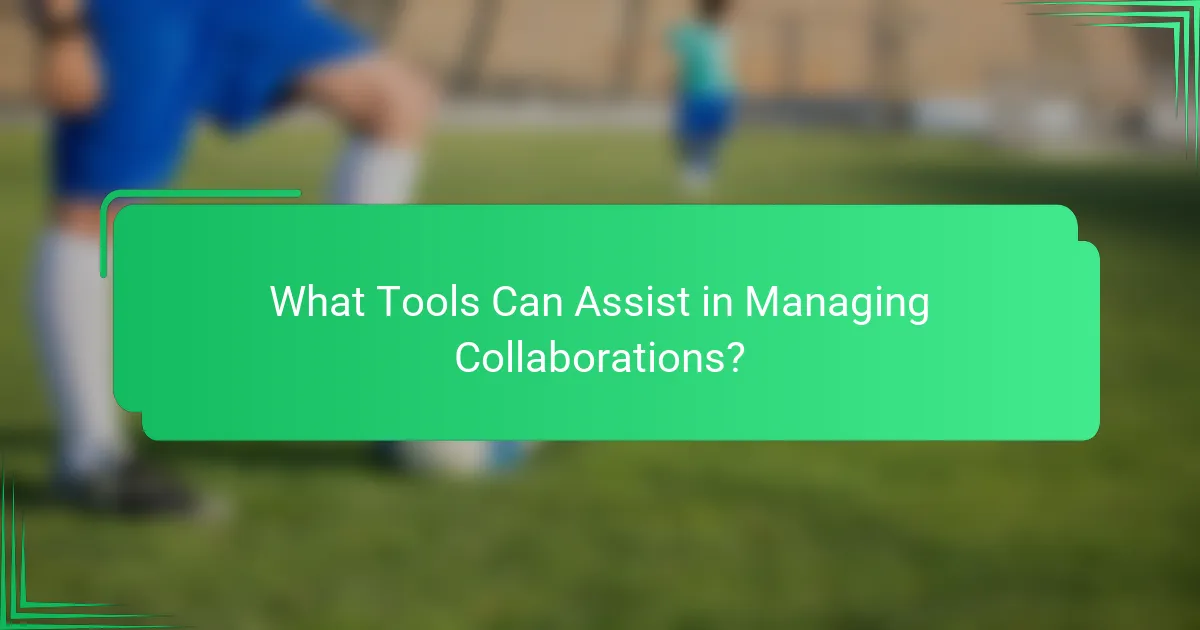
What Tools Can Assist in Managing Collaborations?
Effective collaboration management for indie artists and influencers can be streamlined with the right tools. Utilizing project management software, communication platforms, and analytics tools can enhance coordination, clarity, and performance tracking.
Using Project Management Software
Project management software helps indie artists and influencers organize tasks, set deadlines, and track progress. Tools like Trello, Asana, or Monday.com allow users to create boards or lists that visualize project stages, making it easier to manage multiple collaborations simultaneously.
When selecting software, consider features like task assignment, file sharing, and integration with other tools. A good practice is to choose a platform that offers a free trial to assess its fit for your workflow before committing financially.
Implementing Communication Platforms
Effective communication is crucial for successful collaborations. Platforms such as Slack, Discord, or Microsoft Teams facilitate real-time messaging and file sharing, ensuring all parties stay informed and engaged throughout the project.
Establish clear communication protocols, such as regular check-ins or updates, to prevent misunderstandings. Avoid relying solely on email, as it can lead to delays; instead, prioritize instant messaging for quick discussions.
Tracking Performance with Analytics Tools
Analytics tools are essential for measuring the success of collaborations. Platforms like Google Analytics or social media insights provide data on engagement, reach, and audience demographics, helping artists understand what resonates with their followers.
Regularly review performance metrics to identify trends and areas for improvement. Set specific goals, such as increasing engagement by a certain percentage, and adjust strategies based on the data collected to enhance future collaborations.
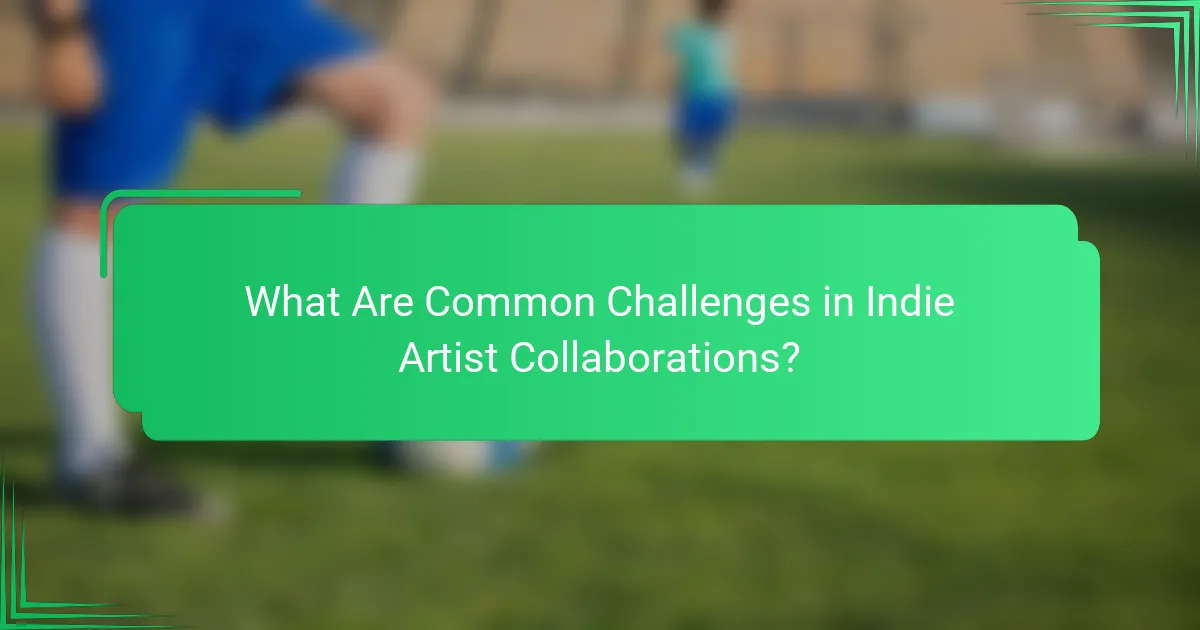
What Are Common Challenges in Indie Artist Collaborations?
Indie artist collaborations often face several challenges that can hinder their success. Key issues include misalignment of goals, communication barriers, and resource limitations, all of which require careful management to ensure productive partnerships.
Misalignment of Goals
Misalignment of goals occurs when collaborating artists have different visions or objectives for the project. This can lead to frustration and conflict, ultimately affecting the quality of the collaboration. To avoid this, it’s essential to establish clear, shared goals from the outset.
For instance, if one artist aims for commercial success while the other prioritizes artistic expression, their collaboration may struggle. Regular check-ins can help ensure both parties remain aligned and can adjust their goals as needed.
Communication Barriers
Effective communication is crucial in any collaboration, but indie artists may face barriers due to different working styles or schedules. Misunderstandings can arise from vague language or assumptions, leading to delays and dissatisfaction.
To mitigate this, artists should establish preferred communication channels and set regular updates. Utilizing tools like project management software can facilitate clearer exchanges and keep everyone on the same page.
Resource Limitations
Resource limitations, including budget constraints and time availability, can significantly impact indie artist collaborations. Many indie artists operate on tight budgets, which can restrict the scope of projects and the ability to hire additional help.
Artists should openly discuss their available resources and set realistic expectations. Creating a budget and timeline together can help identify potential limitations early on, allowing for adjustments that keep the collaboration feasible and productive.
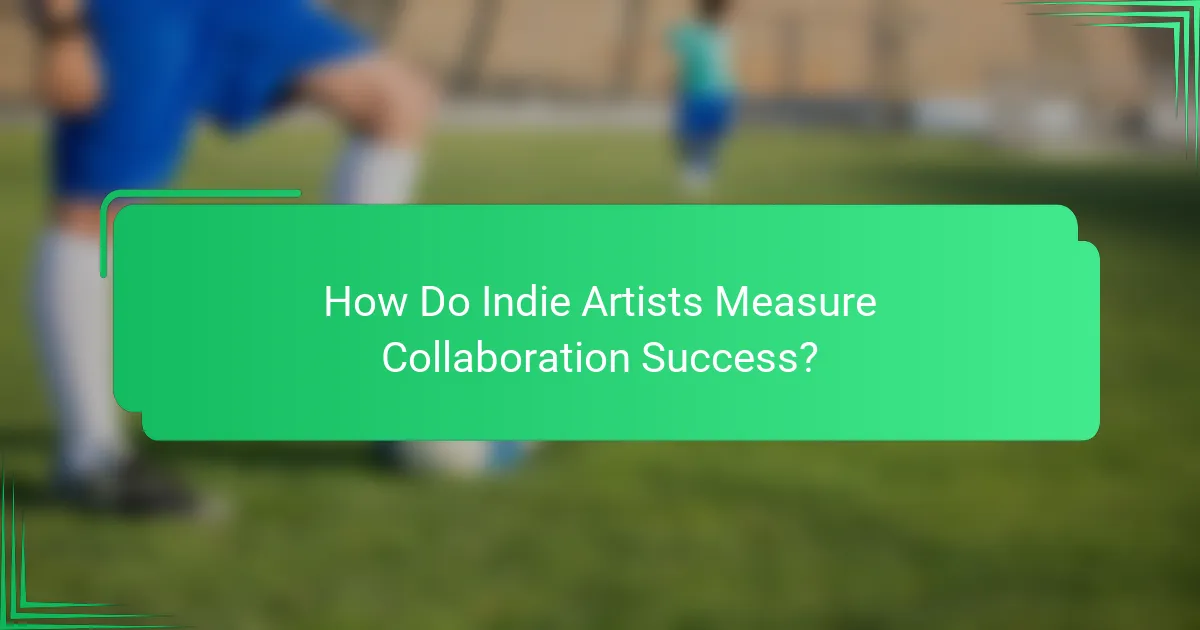
How Do Indie Artists Measure Collaboration Success?
Indie artists measure collaboration success through various metrics, including engagement rates, audience growth, and revenue generated. These indicators help artists understand the impact of their partnerships with influencers and other creators.
Engagement Metrics
Engagement metrics are crucial for assessing how well a collaboration resonates with an audience. Key indicators include likes, shares, comments, and overall interaction rates on social media platforms. For instance, a successful collaboration may see engagement rates exceeding 5% of total followers, indicating strong audience interest.
Artists should track these metrics over time to identify trends and adjust their strategies accordingly. Tools like social media analytics or third-party applications can provide insights into which posts perform best and why.
Audience Growth
Audience growth is another vital measure of collaboration success. An increase in followers or subscribers following a partnership can indicate that the collaboration effectively attracted new fans. Indie artists should aim for a growth rate of at least 10-20% after a successful campaign.
To monitor this, artists can compare their follower counts before and after collaborations, taking note of any spikes in growth. This data can help inform future collaborations and marketing strategies.
Revenue Generation
Revenue generation is a practical measure of collaboration success, particularly for indie artists looking to monetize their work. This can include sales from merchandise, music streams, or ticket sales for events promoted through the collaboration. Artists should track sales data closely to determine the financial impact of each partnership.
Setting clear financial goals before a collaboration can help artists evaluate success more effectively. For example, aiming for a specific percentage increase in merchandise sales can provide a tangible target to assess the collaboration’s effectiveness.
